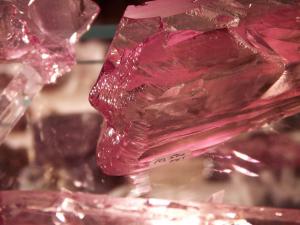This kunzite crystal is not only beautiful, but it contains lithium, a raw material for fusion. In future fusion power stations lithium will be converted into one of the potent fusion fuels, tritium, by neutron bombardment.
Kunzite is a silicate that contains lithium and also aluminium. It also comes in shades of yellow and also a green variety, which is known as hiddenite. Hiddenite crystals can grow to huge sizes—the biggest ever found being over 14 metres long.
There are other lithium-containing minerals: rose or yellow coloured lepidolite, which contains potassium and fluorine, or red-brown lithiophylite, which is lithium manganese phosphate. These are all types of granite, an igneous rock formed by cooling volcanic magma or lava.
The total lithium content in the Earth's crust is estimated at between 20 and 70 parts per million (compared with the content in water of deuterium—fusion's other fuel—which is 35 parts per million). However the economically viable reserves are estimated to be a modest 13 million tonnes.
For comparison, the estimated viable uranium deposits amount to 35 million tonnes—but fusion gives four times more energy per kilogram than uranium. Even the vast coal deposits of the world, estimated at 860 billion tonnes, seem less extensive when you factor in that, per kilogram of fuel, fusion is four million times more efficient than coal at producing energy.
There is much speculation about how long the terrestrial deposits of these fuels might last, but it is perhaps irrelevant. The value of lithium as a potent fusion fuel will doubtless inspire new processing techniques which will enable extraction of lithium from sea water which will end the discussion. The estimated reserves of lithium in the ocean is 230 billion tonnes, several million years' supply.
This story was originally published on the EFDA website.


